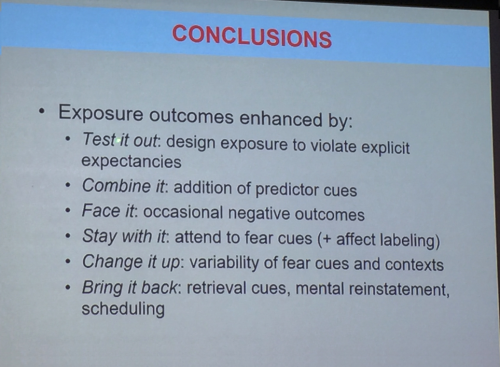Glasgow BABCP conference: Pre-conference workshop - Michelle Craske on 'Exposure therapy in the 21st century' (1st post)
Last updated on 30th July 2018
This pre-conference workshop with Michelle Craske on "Exposure in the 21st century" was great. A few years ago - in the blog post "Maximising exposure therapy" - I wrote "Michelle Craske & colleagues from the Anxiety Disorders Research Center of UCLA have, for many years, been publishing careful, challenging research on underlying mechanisms & on ways of boosting the effectiveness of exposure therapies for different forms of anxiety. Michelle's list of publications & research presentations runs to 50 pages and begins with a study on musical performance anxiety published in 1984. As the presentation titles on her list show, for some years the majority of her many lectures at prestigious conferences all over the world have revolved around the theme of how to take evolving scientific findings about fear learning and use them to optimize exposure treatments for anxiety disorders. Her recent paper "Maximizing exposure therapy: An inhibitory learning approach" is something of a tour de force in this area. Its abstract reads "Exposure therapy is an effective approach for treating anxiety disorders, although a substantial number of individuals fail to benefit or experience a return of fear after treatment. Research suggests that anxious individuals show deficits in the mechanisms believed to underlie exposure therapy, such as inhibitory learning. Targeting these processes may help improve the efficacy of exposure-based procedures. Although evidence supports an inhibitory learning model of extinction, there has been little discussion of how to implement this model in clinical practice. The primary aim of this paper is to provide examples to clinicians for how to apply this model to optimize exposure therapy with anxious clients, in ways that distinguish it from a ‘fear habituation’ approach and ‘belief disconfirmation’ approach within standard cognitive-behavior therapy. Exposure optimization strategies include 1) expectancy violation, 2) deepened extinction, 3) occasional reinforced extinction, 4) removal of safety signals, 5) variability, 6) retrieval cues, 7) multiple contexts, and 8) affect labeling. Case studies illustrate methods of applying these techniques with a variety of anxiety disorders, including obsessive-compulsive disorder, posttraumatic stress disorder, social phobia, specific phobia, and panic disorder."
Good stuff. I sometimes say that, if I was only allowed one method for helping people struggling with anxiety, I would probably choose exposure techniques. However Michelle states that currently about 30% of eligible anxiety sufferers refuse to try exposure methods. About another 25% drop out of treatment. And of those who do go through with the exposure, only about 55% achieve 'clinically significant' improvement (not 'cure') and of this 55% most will experience some return of fear over the months & years following treatment. Not so great. Actually exposure-based techniques are often not adequately available - see, for example, "Has evidence-based psychosocial treatment for anxiety disorders permeated usual care in community mental health settings?" with its comment "The majority of the psychosocial treatment delivered was supportive therapy. Among the minority of patients who did initiate CBT, an even smaller minority received treatment that included an exposure component, and those who did receive exposure likely received a sub-optimal dose." And even when therapists are trained in this approach, the therapists' own anxiety may interfere with applying exposure adequately - see "Facets of clinicians' anxiety and the delivery of cognitive behavioral therapy" with its finding that "Overall, higher anxiety levels (in therapists) were associated with a poorer use of exposure methods or with a greater use of other behavioral or cognitive methods." Adequately applied exposure-based approaches are effective - e.g. "Cognitive therapy versus exposure therapy for hypochondriasis (health anxiety): A randomized controlled trial" and this year's "What matters more? Common or specific factors in cognitive behavioral therapy for OCD". Exposure is a treatment that can help many people, but there's clearly a good deal of improvement needed. Today's workshop description comments "Translation from the basic science of inhibitory extinction learning and inhibitory regulation offers strategies for increasing response rates to exposure therapy. This workshop will present application of these strategies, including prediction error correction ('violation of expectancy'), variability across stimuli and contexts to enhance generalization, interference with hippocampal activation to enhance context generalization, bridging techniques to retrieve exposure memories in novel contexts, induction of positive valence, and linguistic processing ('affect labeling') of feared stimuli." Underneath the jargon there are some very interesting ideas for improving the helpfulness of exposure here. Here's a slide illustrating how much research has gone into the development of Michelle's approach:

And here's the concluding slide from this half day workshop:

In the second of two blog posts on Michelle's workshop, I'll take these six suggestions one at a time to look more closely at what they each involve.
